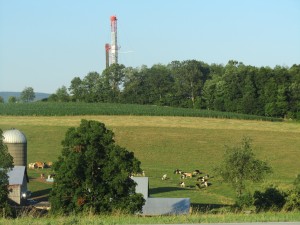EPA Blames Fracking for Wyoming Groundwater Contamination
For the first time, federal environmental regulators have made a direct link between the controversial drilling practice known as hydraulic fracturing and groundwater contamination.
The EPA released on Thursday its draft investigation results on water pollution in the Wyoming town of Pavilion.
This federal finding linking “fracking” and groundwater pollution could have widespread repercussions. Several states, including New York and Pennsylvania, are in the midst of creating new gas-drilling regulations. Up until this report, industry representatives, along with the head of Pennsylvania’s Department of Environmental Protection, have said no persuasive evidence exists linking fracking directly to problems with water quality. DEP Secretary Michael Krancer recently testified in Congress that the idea that fracking pollutes groundwater is “bogus.”
Residents of Pavilion, Wy., began complaining about drinking water that smelled like chemicals back in 2008. Intensive drilling for natural gas in the area began in the late 1990’s and continued until 2006. The area now has 169 natural gas wells.
The draft report says investigators have found compounds in Pavilion’s groundwater associated with fracking. The EPA found high concentrations of benzene, xylene, gasoline and diesel fuel in shallow groundwater supplies that they linked to wastewater pits. But the report also found a number of fracking chemicals in much deeper fresh water wells.
“Alternative explanations were carefully considered to explain individual sets of data. However, when considered together with other lines of evidence, the data indicates likely impact to ground water that can be explained by hydraulic fracturing.”
Hydraulic fracturing is a method to extract oil and gas from underground deposits. It uses a mixture of sand, water and chemicals to fracture shale rock and release the gas. The EPA draft report found chloride, isopropanol, diethylene glycol, triethylene glycol, and tert-butyl alcohol in the deeper test wells. The report indicates the difficulty tracking the chemicals because the gas industry is not required to reveal all chemical elements.
“Material Safety Data Sheets do not indicate that fuel or tert-butyl hydroperoxide were used in the Pavillion gas field. However, Material Safety Data Sheets do not contain proprietary information and the chemical ingredients of many additives. The source of tert-butyl alcohol remains unresolved. However, tert-butyl alcohol is not expected to occur naturally in ground water.”
The report also links high levels of methane to gas drilling.
“Although some natural migration of gas would be expected above a gas field such as Pavillion, data suggest that enhanced migration of gas has occurred within ground water at depths used for domestic water supply and to domestic wells. Further investigation would be needed to determine the extent of gas migration and the fate and transport processes influencing migration to domestic wells.”
The draft report highlights the need for baseline water testing before drilling begins near drinking water sources.
“Finally, this investigation supports recommendations made by the U.S. Department of Energy Panel (DOE 2011a, b) on the need for collection of baseline data, greater transparency on chemical composition of hydraulic fracturing fluids, and greater emphasis on well construction and integrity requirements and testing. As stated by the panel, implementation of these recommendations would decrease the likelihood of impact to ground water and increase public confidence in the technology.”
Pennsylvania is the only state that does not require baseline testing of private well water.
The Calgary, Alberta-based Encana, which owns the Pavillion gas field, told the AP that it has concerns about the study.
Encana spokesman Doug Hock said there was much to question about the draft study.
The compounds EPA said could be associated with fracking, he said, could have had other origins not related to gas development.
“Those could just have likely been brought about by contamination in their sampling process or construction of their well,” Hock said.
The AP also quoted Oklahoma Republican Senator James Inhofe as saying the study was “not based on sound science but rather on political science.”
“Its findings are premature, given that the Agency has not gone through the necessary peer-review process, and there are still serious outstanding questions regarding EPA’s data and methodology,” Inhofe said in a statement.
The EPA details their research into other possible causes for the contamination, but says the evidence points to hydraulic fracturing chemicals used in gas drilling. A spokeswoman for the Department of Environmental Protection says they’re still reviewing the report, and will issue a public statement. In the meantime, DEP spokeswoman Katy Gresh says fracking has not polluted water in Pennsylvania. “It is important to note that there are no documented cases of hydraulic fracturing impacting a water supply in Pennsylvania,” says Gresh.
The EPA’s report will now undergo a peer review process.

















